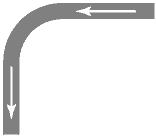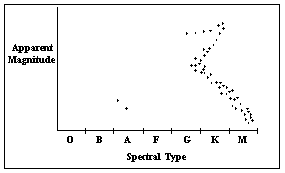The diagram shown represents a portion of a wire in a circuit. A current is flowing in the wire in the direction shown. Under the convention that it is positive charge that flows the electric field points in the direction of the current. How can the electric field change direction where the wire bends?

a.
There is an excess of negative charge in the center of the wire.
b.
There is an excess of positive charge at the bottom end of the wire.
c.
There is an excess of negative charge at the right end of the upper portion of the wire.
d.
There is an accumulation of positive charge on the surface, particularly at the bend, such that the sum of electric fields gives the new electric field.
e.
There is an accumulation of electrical potential as the current traverses the wire: The higher potential in the lower half is the source of the field.
d
You might also like to view...
What is the approximate age of the star cluster in the HR diagram below? (Hint: Main Sequence Stars of spectral between types A and B core supply of hydrogen is sufficient to last about 250 million years. Between A and F about 2 billion years.Type G about 10 billion years. Between K and M about 30 billion years..)

a.
200 million years
b.
2 billion years
c.
10 billion years
d.
30 billion years
e.
The age of the cluster can not be estimated from an HR diagram of the cluster.
Compare the Copernican principle with the assumptions of mediocrity
What will be an ideal response?
A positive point charge q is placed at the center of an uncharged metal sphere insulated from the ground. The outside of the sphere is then grounded as shown. Then the ground wire is removed. A is the inner surface and B is the outer surface. Which statement is correct?

a.
The charge on A is ?q; that on B is +q.
b.
The charge on B is ?q; that on A is +q.
c.
The charge is on A and on B.
d.
There is no charge on either A or B.
e.
The charge on A is ?q; there is no charge on B.
10 joules of heat energy are transferred to a sample of ideal gas at constant pressure. As a result, the internal energy of the gas
A. increases by 10 J B. increases by less than 10 J C. increases by more than 10 J D. remains unchanged.